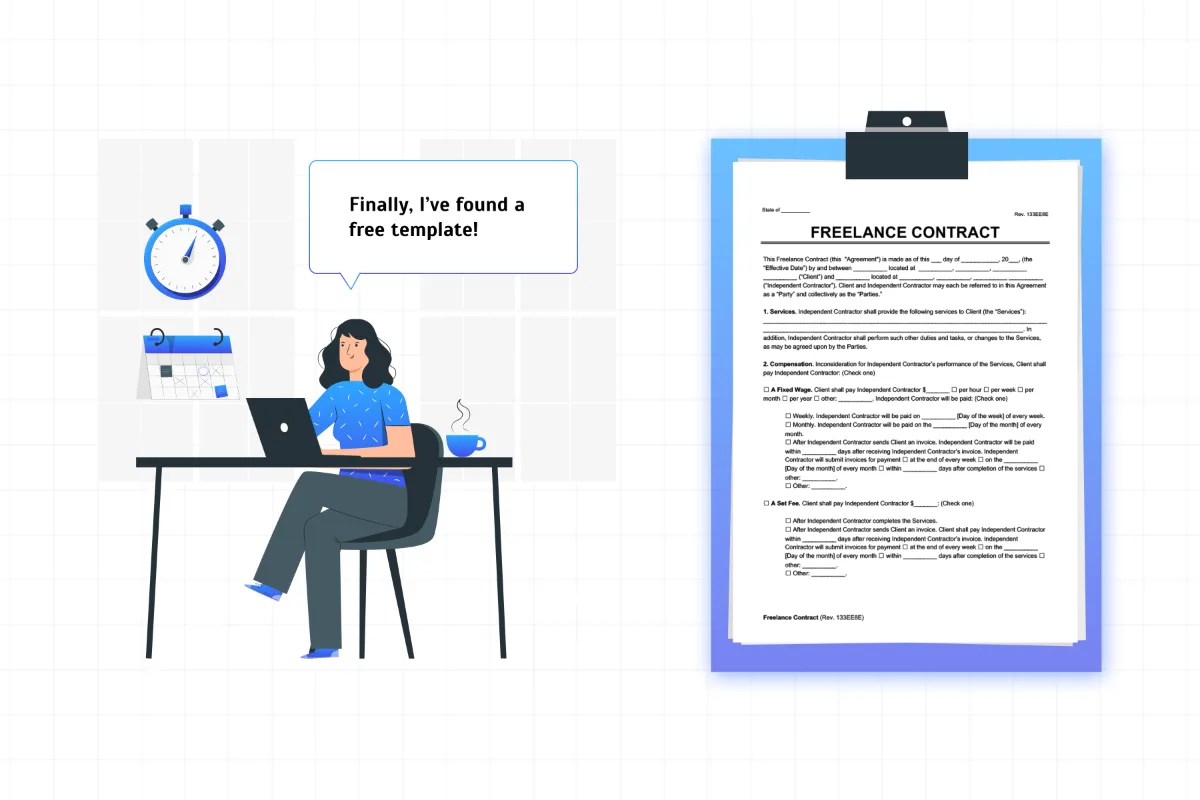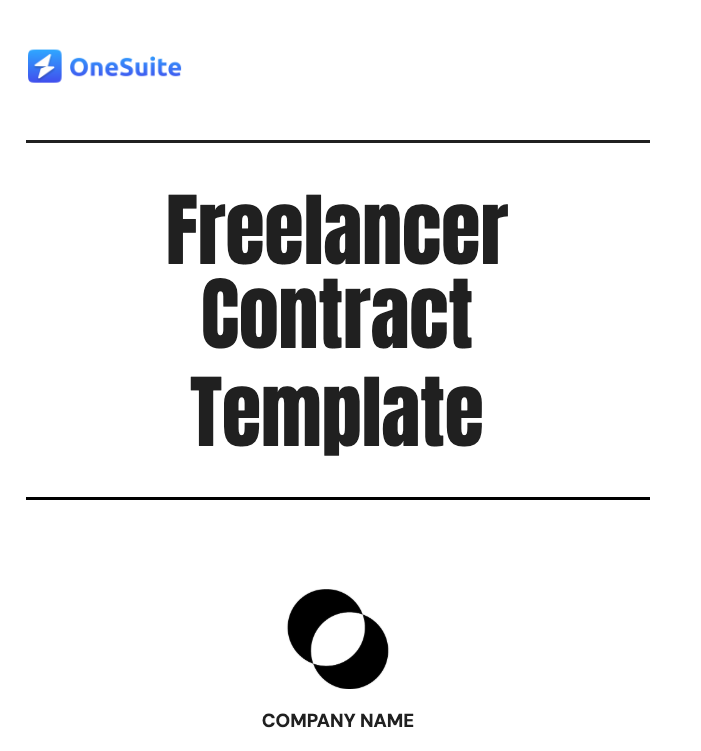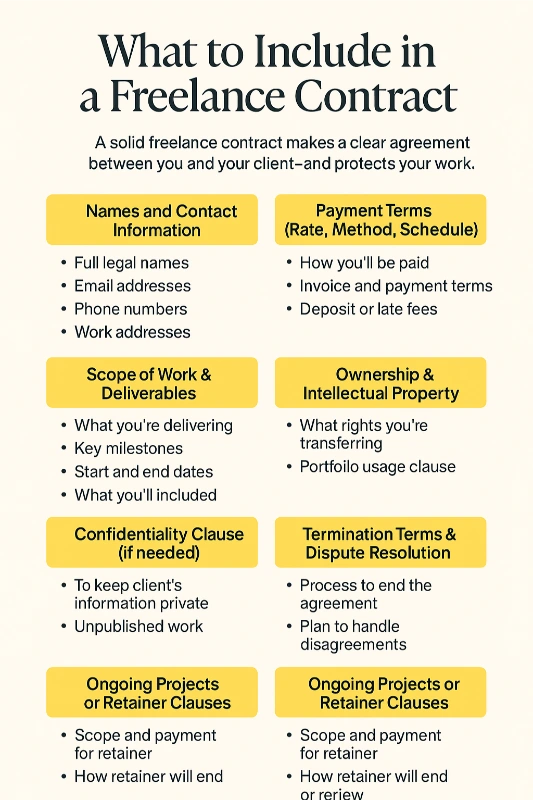
Freelancing offers freedom, flexibility and the chance to build a career on your terms. But without the proper foundation in place that freedom can quickly turn into frustration.
Whether you’re designing logos, writing code, or managing content calendars, one thing every freelancer needs is a clear, written contract. It’s not just legal red tape—it’s your safety net.
A freelance contract sets expectations upfront: what work you’ll do when you’ll deliver it, how much you’ll get paid, and who owns the final product. Without it, things get messy fast.
In fact, according to Upwork’s 2023 report, over 60% of freelancers have dealt with late payments or disputes—often because there was no formal agreement to fall back on.
In this guide, I’ll walk you through:
- Why every freelancer needs a contract (even for small jobs)
- What to include so you don’t get burned later
- How to personalize this template in minutes
- And how to send and sign it fast using tools like OneSuite
Every editable part is highlighted in yellow — fill it in, send it out, and get it signed.
If you’ve ever chased a late payment, been buried in scope creep, or wanted to feel more confident walking into a project — this contract is for you.
⚠️ Disclaimer: I’m not a lawyer, and this isn’t legal advice. Always speak to a qualified attorney when drafting contracts.
Free Freelance Contract Template Template
Before we dive in—if you’re here for the contract, go ahead and grab it now:
How to Use and Customize This Freelance Contract Template
We know filling out contracts can feel like extra work but this one is built to be easy, clear, and fast.
Every section you need to personalize is marked in 🟨 yellow so you can quickly scan, fill in your details, and send it off professionally.
Just follow these steps:
Step 1: Fill in the Yellow Sections
Anywhere you see a yellow highlight, that’s where you need to add or edit your own information:
- Your name, business name (if applicable), and contact info
- Your client’s full name and contact details
- Project title, start date, and overall scope of work
- Timeline and delivery deadlines
- Your pricing structure (hourly, fixed fee, retainer, etc.)
- Payment schedule and preferred method
- Revisions, expenses, or any custom terms you’ve agreed on
- Signatures and dates at the bottom
Tip: Keep your descriptions specific — the clearer the scope and timeline, the easier it is to avoid misunderstandings later.
Step 2: Share and Review with Your Client
Before anyone signs, send the draft to your client for review.
Check these key items together:
- Are the services listed accurate?
- Is the price and payment schedule correct?
- Are deadlines realistic?
- Do both parties understand copyright or usage terms?
Step 3: Clean Up the File
Once everything’s approved:
- Remove the yellow highlights
- Double-check formatting and spacing
- Save a clean final version as a PDF
Step 4: Sign and Send
Use any e-signature tool like OneSuite, or even Google Docs with typed signatures. Make sure both parties receive a copy and save it securely.
Most platforms offer a free trial—perfect if you’re just starting.
👇 Watch how to send and sign your agreement in less than 3 minutes:
What Is a Freelance Contract?
A freelance contract is a written agreement between a freelancer and a client that outlines the scope of work, deadlines, payment terms, and legal responsibilities. It defines what services will be provided, how and when they will be delivered, and how the freelancer will be compensated.
Accroding to Founder of Winning Solo Matthew Fenton :
“Contracts are meant to be negotiated. As a freelancer, you can (and should) go back to the client with clauses of your own to ensure you get paid on time and are protected against possible risks.”
This contract helps protect both parties by setting clear expectations and reducing the risk of misunderstandings. Freelancers use these agreements to ensure they are paid fairly and on time, while clients use them to confirm deliverables and timelines.
A freelance contract brings structure, professionalism, and legal clarity to any short-term or project-based working relationship.

Risks of Not Using a Freelance Contract
The Freelancers Union emphasizes that “a solid contract is the freelancer’s best defense against non-payment and scope creep,” making it an indispensable tool for sustainable freelance careers.
If you’ve ever started a project with a handshake or a few casual emails, you’re not alone. Many freelancers skip the contract, especially when the work seems straightforward. However, that’s usually when problems arise.
Here’s what can happen when there’s no contract in place:
- You don’t get paid—or it’s delayed: You deliver the work, but the client disappears or argues about the price. Without anything in writing, chasing payment becomes harder than doing the work.
- The project keeps growing: You agreed to one task, but now the client wants “just a few more things.” Suddenly, you’re doing double the work for the same fee. It happens more often than you’d think.
- Expectations can get blurry: Perhaps you thought they wanted a summary, but they expected a comprehensive report. A contract ensures that both sides are clear before anything begins.
- You lose control of your work: Clients might use your work in ways you never agreed to—like reselling, rebranding, or publishing it without credit.
- There’s no straightforward way out if something goes wrong: If the relationship goes off track, not having a written agreement makes things messy fast.
Even if you’ve never had an issue, all it takes is one bad experience to realize how important a contract is. It’s not about being difficult—it’s about protecting your time, your work, and your peace of mind.
What to Include in a Freelance Contract ?
A solid freelance contract does more than protect your work. It sets the tone for a smooth, professional collaboration. Whether you’re writing one from scratch or tweaking a template, including the right terms can save you from future headaches.
Every project is different, but there are some key clauses most freelancers find helpful. Below, I’ve shared the ones I’ve used (and seen work well) so you can build a contract that fits your workflow and protects your time.
Please note: This is not legal advice but rather a practical guide based on what many freelancers typically include in their contracts.

Names and Contact Information
Every freelance contract should start with the basics: who’s involved. List both your name and the client’s name, along with accurate contact details. It isn’t just formal—it ensures you both know who is responsible for what and how to contact each other if an issue arises.
Include:
- Full legal names (individual or business)
- Email addresses
- Phone numbers
- Work addresses (if relevant)
Keeping this info clear helps avoid confusion, especially if the project lasts a while or shifts between teams.
Scope of Work & Deliverables
It is where you define exactly what you’re being hired to do. Be clear. Be specific. The more detail you include, the fewer surprises later. A vague scope can lead to extra requests, unpaid tasks, and frustration on both sides.
Make sure to include:
- What you’re delivering (write it like a checklist if needed)
- Key milestones or phases
- Start and end dates
- What’s not included
- Any tools or input you’ll need from the client
This section sets the boundaries. It keeps the project focused and protects your time.
Assign clear responsibilities, set deadlines, and break tasks into smaller, actionable steps—you can manage it all easily with our Project Management Solutions inside OneSuite.
Timeline & Deadlines
It’s essential to clearly outline when the project will commence, its expected duration, and the deadlines for key deliverables. This helps manage expectations on both sides and keeps the project organized. You can also include how quickly feedback is needed and note any days you’re unavailable to avoid misunderstandings during the process.
Payment Terms (Rate, Method, Schedule)
This section should explain precisely how you’ll be paid—whether it’s a flat fee, hourly rate, or based on milestones. Ensure that you include the following details: when invoices will be sent, when payment is due, and the payment methods you accept. If you require a deposit upfront or charge late fees, please specify this here. Clear terms help prevent delays and maintain a professional workflow.
Ownership & Intellectual Property
Once the project is complete and payment is made, most clients expect to own the final work in full. Your contract should clearly state who holds the rights to what.
If you’re transferring ownership to the client, make that clear. They’ll be free to use, modify, or resell the work however they choose.
However, if you’re retaining rights to certain elements, such as source files, templates, or unused concepts, be sure to note that as well.
Additionally, if you wish to share the work in your portfolio, please specify this upfront. Some clients are okay with it, while others may prefer to keep the project private—especially in cases such as ghostwriting or white-label work.
Being upfront about ownership protects your work and sets the right expectations from the start.
Confidentiality Clause (if needed)
If you’ll be handling sensitive information such as internal documents, strategic plans, or client data it’s worth adding a confidentiality clause. This means you agree not to share any private info you access during the project.
The same goes for your client—they shouldn’t disclose your process, pricing, or unpublished work without permission.
Depending on the project, a separate non-disclosure agreement (NDA) might be needed. However, for many freelancers, a simple confidentiality clause in the contract is sufficient.
It builds trust and reassures your client that their information is safe with you.
Termination Terms & Dispute Resolution
Sometimes, things change or just don’t work out. That’s why your contract should explain how either side can end the agreement. Include how much notice is required (like 14 or 30 days), how that notice should be given (usually in writing), and what happens to any unfinished work or payments.
It’s also smart to add a short process for handling disputes. For example, you can agree to discuss things first and, if needed, bring in a neutral third party to help. This ensures fairness and prevents surprises.
Ongoing Projects or Retainer Clauses
If you work with a client regularly—like on monthly tasks or long-term support—a retainer clause helps keep things clear.
You can include:
- What work is included each month
- How many hours you’re committing
- Your monthly rate and when payment is due
- What happens if the client doesn’t use all the time (does it roll over or expire?)
- How can either side end the agreement with notice
It makes it easier to plan your time, and it gives both sides a steady working structure.
Read also : Get a free, agency-friendly Independent contractor agreement template for 2025. Ideal for hiring freelancers, creatives, or remote contractors.
Create a Free Freelancer Contract template with Onesuite
Creating a free Freelancer Contract template in OneSuite is quick and hassle-free. Start by clearly outlining all services, deliverables and payment terms. You can either upload your finalized contract as a Docs file or use OneSuite’s editor to create it directly within the platform.
Here’s how to get started:
- Write Your Contract – Use OneSuite’s editor to create a clear contract outlining your services, deliverables, and payment terms.
- Upload to OneSuite – Go to the Documents section and upload your contract.
- Add Signature Fields – Add fields for both you and your client to sign and date the contract.
- Link to Client Profile – Attach the contract to the client’s profile for easy tracking.
- Send for Signature – Send the contract to your client via a secure link for signing.
- Lock Contract Automatically – Once signed, the contract will be locked automatically, providing a legally verified document.
- Save as a Template – Save the contract as a reusable template for future projects.
Ready to streamline your contract process? Create your free Freelancer Contract template today with OneSuite! Save time, eliminate paperwork hassles and ensure smooth client projects.
Frequently Asked Questions (FAQs)
Is a freelance contract legally binding?
Yes, a freelance contract is legally binding once both parties sign it. As long as it includes clear terms (scope of work, payment, deadlines, etc.) and mutual agreement, it can be enforced in most legal systems. It protects both the freelancer and the client in case of disputes.
Do I need to send a contract as a freelancer?
Yes — always send a contract before starting any project, no matter how small. A contract sets expectations, defines deliverables, and protects you from issues like late payments or scope creep. It shows professionalism and builds trust with your client.
Can you break a freelance contract?
Yes, but there should be a clause in the contract outlining how either party can terminate the agreement. Most freelance contracts include a termination notice period (e.g., 14 or 30 days). Breaking a contract without notice or reason could result in legal or financial consequences.
Conclusion:
I’ve learned the hard way that a handshake or a casual email isn’t always enough. A clear, signed contract saves so much stress — no more chasing payments, redoing work you didn’t agree to, or dealing with last-minute surprises.
That’s why I built this freelance contract template: to help both of us work smarter and protect what we create.
It’s simple to fill out, easy to share, and gives me the peace of mind I need before diving into any new project. I hope it does the same for you.
Just don’t forget — a contract isn’t official until it’s signed.
👉 Start your 14-day free trial with OneSuite
I use it to fill, send, and get my contracts signed in minutes — no printing, no scanning, just a clean, professional way to start every project right.
Let’s protect our work — and our sanity — from the start.
Find a Better Way to Grow
OneSuite streamlines projects, clients, and payments in one place, making growth hassle-free.

